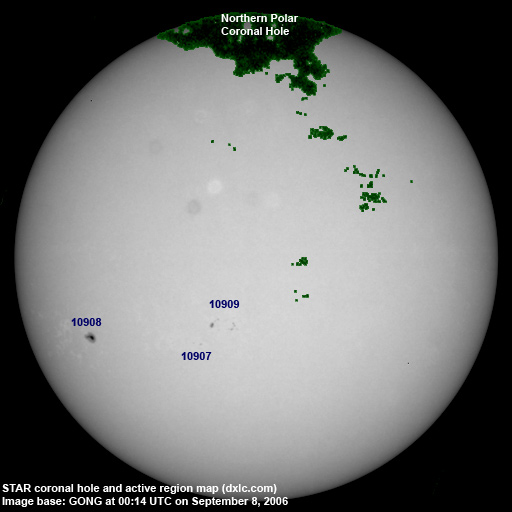

Last major update issued on September 8, 2006 at 02:55 UTC.
[Solar and
geomagnetic data - last month (updated daily)]
[Solar wind and
electron fluence charts (updated daily)]
[Solar cycles 21-23
(last update September 3, 2006)]
[Solar cycles 1-20]
[Graphical comparison
of cycles 21, 22 and 23 (last update September 3, 2006)]
[Graphical
comparison of cycles 2, 10, 13, 17, 20 and 23 (last update September 3, 2006)]
[Historical solar and
geomagnetic data charts 1954-2005 (last update March 3, 2006)]
[Archived reports (last update
September 8, 2006)]
The geomagnetic field was quiet to active on September 7. Solar wind speed ranged between 414 and 447 km/s (all day average 438 km/s - decreasing 12 km/s from the previous day).
Solar flux measured at 20h UTC on 2.8 GHz was 86.7. The planetary A index was 8 (STAR Ap - based on the mean of three hour interval ap indices: 8.3). Three hour interval K indices: 22412221 (planetary), 12422221 (Boulder).
The background x-ray flux is at the class A7 level.
At midnight there were 3 spotted regions on the visible solar disk. The solar flare activity level was very low. No C class events were recorded during the day.
Region 10907 decayed and could soon become spotless.
Region 10908 was mostly unchanged and quiet.
Region 10909 is somewhat unstable and capable of producing C class
flares.
September 5-7: No obvious partly or fully Earth directed CMEs were detected in incomplete LASCO imagery.
Coronal hole history (since late October 2002)
Compare today's report to the situation one solar rotation ago:
28 days ago
27 days ago
26 days ago
No obvious coronal holes are currently in or near Earth facing positions.

Processed SOHO/EIT 284 image at 19:08 UTC on August 18. The darkest areas on the solar disk are likely coronal holes.
The geomagnetic field is expected to be mostly quiet on September 8-14.
| Coronal holes (1) | Coronal mass ejections (2) | M and X class flares (3) |
1) Effects from a coronal hole could reach Earth
within the next 5 days. When the high speed stream has arrived the color changes to green.
2) Effects from a CME are likely to be observed at Earth within 96 hours.
3) There is a possibility of either M or X class flares within the next 48 hours.
Green: 0-20% probability, Yellow: 20-60% probability, Red: 60-100% probability.
Long distance low and medium frequency (below 2 MHz) propagation along east-west paths over high and upper middle latitudes is poor to fair. Very few stations from North America were audible at night. Instead stations further south on or near the same path, primarily from Cuba, Colombia and Venezuela, enjoyed better than average propagation. Propagation on long distance northeast-southwest paths is poor. On September 7 post sunrise reception of stations from South America was good, in particular from Uruguay with unusual stations like 550 Radio Colonia, 580 Radio Clarín and 730 Radio Continente all heard at low to fair signal levels during the first hour after LSR.

Compare to the previous day's image.
Data for all numbered solar regions according to the Solar Region Summary provided by NOAA/SEC. Comments are my own, as is the STAR spot count (spots observed at or inside a few hours before midnight) and data for regions not numbered by SEC or where SEC has observed no spots. SEC active region numbers in the table below and in the active region map above are the historic SEC/USAF numbers.
| Active region | Date numbered | SEC spot count |
STAR spot count |
Location at midnight | Area | Classification | Comment |
|---|---|---|---|---|---|---|---|
| 10907 | 2006.09.05 | 3 | 2 | S13E17 | 0020 | CSO | classification was CRO at midnight |
| 10908 | 2006.09.05 | 1 | 2 | S13E45 | 0210 | HAX | |
| 10909 | 2006.09.06 | 5 | 7 | S09E09 | 0030 | CAO | area was 0050 at midnight |
| Total spot count: | 9 | 11 | |||||
| SSN: | 39 | 41 | |||||
| Month | Average solar flux at Earth |
International sunspot number | Smoothed sunspot number |
|---|---|---|---|
| 2000.04 | 184.2 | 125.5 | 120.8 cycle 23 sunspot max. |
| 2000.07 | 202.3 | 170.1 | 119.8 |
| 2001.12 | 235.1 | 132.2 | 114.6 (-0.9) |
| 2005.07 | 96.4 | 40.1 | 29.1 (+0.3) |
| 2005.08 | 90.5 | 36.4 | 27.4 (-1.7) |
| 2005.09 | 91.1 | 21.9 | 25.8 (-1.6) |
| 2005.10 | 77.0 | 8.5 | 25.5 (-0.3) |
| 2005.11 | 86.3 | 18.0 | 24.9 (-0.6) |
| 2005.12 | 90.7 | 41.2 | 23.0 (-1.9) |
| 2006.01 | 83.4 | 15.4 | 20.8 (-2.2) |
| 2006.02 | 76.5 | 4.7 | 18.6 (-2.2) |
| 2006.03 | 75.4 | 10.8 | (17.1 predicted, -1.5) |
| 2006.04 | 89.0 | 30.2 | (16.4 predicted, -0.7) |
| 2006.05 | 80.9 | 22.2 | (15.9 predicted, -0.5) |
| 2006.06 | 76.5 | 13.9 | (14.1 predicted, -1.8) |
| 2006.07 | 75.7 | 12.2 | (12.4 predicted, -1.7) |
| 2006.08 | 79.0 | 12.9 | (11.9 predicted, -0.5) |
| 2006.09 | 79.9 (1) | 5.6 (2) | (11.9 predicted, -0.0) |
1) Running average based on the
daily 20:00 UTC observed solar flux
value at 2800 MHz.
2) Unofficial, accumulated value based on the Boulder (NOAA/SEC)
sunspot number. The official international sunspot number is typically
30-50% lower.
This report has been prepared by Jan Alvestad. It is based partly on my own observations and analysis, and partly on data from some of these solar data sources. All time references are to the UTC day. Comments and suggestions are always welcome.
| [DX-Listeners' Club] |